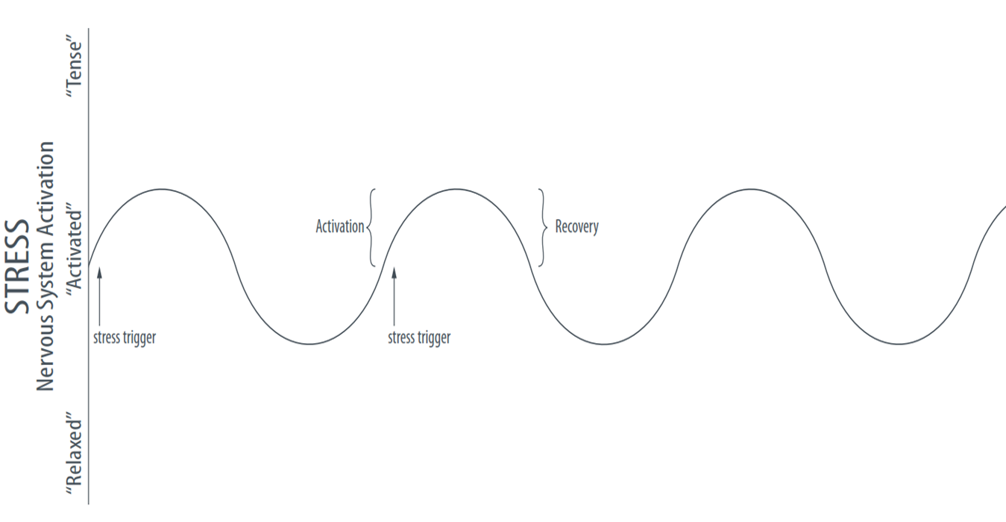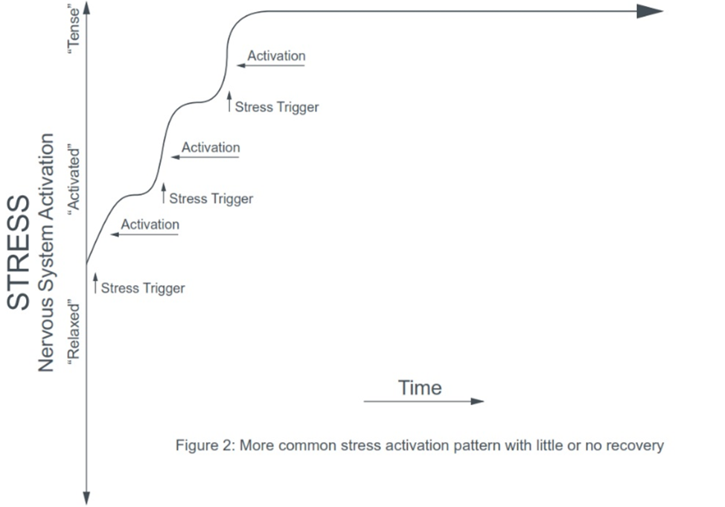In working with peak performing athletes I found that in preparing them for high pressure situations the more they practiced the basic moves or actions of their sport, making them second nature, the better they handled the pressure. With their ability to perform these basics automatically, it established confidence and a foundation to perform well in the most intense circumstances. The current Coronavirus crisis can be considered the equivalent for all of us and the recovering addict, to the athlete’s high-pressure situation.
Stress throws the body out of balance
We are all challenged by the constant impact of stress in our lives. Stress activates the sympathetic branch of your autonomic nervous system, engaging all systems of the body. Heart rate and blood pressure rise, breathing becomes rapid and shallow, muscles tense and various hormones get released that circulate throughout the body. While this response is healthy and important in dealing with threat, its ongoing activation, without the compensatory engagement of the parasympathetic, or recovery branch of the nervous system, creates a cascading series of events that becomes harmful and even dangerous.


Figure 1 shows a healthy pattern of activating the nervous system to stress, and then engaging parasympathetic recovery, so that the body is ready for the next stressful situation. Under these balanced circumstances, the stress response helps by increasing focus and attention and mobilizing the body to perform at its best. Unfortunately, figure 2 is a more typical pattern in which we engage the stress response, but before there is any recovery, we find another stress to respond to. It doesn’t matter if the stress is real or imagined, the response will still occur.
The problem is that this pattern leads to the loss of the ability to self-regulate, or to engage the recovery branch of the nervous system. It’s like taking a rubber band and stretching it, and before you give it a chance to return to its relaxed state, you stretch it again, and then again. The result is that the rubber band is likely to break, tear, or at least lose its flexibility. Like the rubber band, when this happens, we are vulnerable to some loss of function or breakdown in our body. We experience a range of symptoms as well as illness, anxiety and emotional distress.
Stress increases vulnerability to relapse:
Stress disrupts new coping skills, creates discomfort, and increases craving in recovering addicts. In both human and animal studies the greater the stress the more vulnerable an organism is to relapse. The current crisis only adds to the already difficult process of recovery and the stresses that a recovering addict face. One of my clients one said that addiction is like driving down the highway in your station wagon (now it would be your SUV) and throwing all your bills, tickets, and summons in the back seat. When you get sober it’s like jamming on the break and having everything from the back seat flying forward onto your lap.
The reaction to stress and the inability to recovery from stressful experiences results in physical and emotional discomfort. When the recovering addict feels this discomfort without the ability to relax or feel comfortable in their own skin, they become anxious and scared. When this happens, they have less access to new learning – new coping skills – and this intensifies the anxiety and fear. Access to the prefrontal cortex is further impaired as they resort to more primitive or older coping. This leads to craving and relapse.
Training the ability to self-regulate
The Coronavirus crisis presents added pressure on the recovery process. Like the peak performing athletes, recovering addicts in this high-pressure situation need to be able to fall back on some basic “moves”. I have been emphasizing in “Resilient Recovery” the importance of developing autonomic self-regulation as the basic “move” in staying abstinent. This is the ability to turn down the activation of your nervous system, to recover after a stressful situation and to be able to create a state of internal calm. By gaining this ability an addict will experience an added sense of confidence and control, much needed during their recovery and stressful experiences.
Four-step process for developing the ability to self-regulate:
Here is a four-step process that helps a person gain greater control over their responses to stress:
- Create the proper environment for learning self-regulation
Those in recovery are challenged in their ability to learn, particularly due to the dysregulation of their nervous system. Creating the optimal conditions include:
- Create “psychological space”. Acceptance and patience are key to learning. Since it doesn’t occur immediately one must give it time to develop and not prematurely judge that it isn’t working. Here is a link to a blog I published for Psychology Today on the subject:
https://www.psychologytoday.com/us/blog/path-optimal-living/201809/what-is-psychological-space
- “Zone of safety”. It is important to declare, before practice, that you are safe, that nothing can happen to you in the next 15-20 minutes, and thus you can totally let go, and let down your guard. This is necessary for learning to relax.
- Shelve all unfinished business. Declare that anything that has been a concern can be put on a shelf for the next 20 minutes. That includes any thinking or problem solving.
- Tolerate discomfort. Turning down the activation of your nervous system can bring you in touch with uncomfortable feelings. Let this be ok for the next 20 minutes.
- Heart Rate Variability: This refers to the inherent variations in our heart rate pattern. There is an optimal pattern in which heart rate speeds up with breathing in and slows down with breathing out. When this happens, it facilitates physiological healing. Breathing at six breaths per minute, brings into alignment several physiological rhythms to support healthy heart rate variability. Furthermore, focusing on positive feelings of gratitude has been shown to enhance this rhythm.
- Practicing a relaxation exercise: There is no substitute for practicing a relaxation exercise to regain self-regulation. As noted in figure 2, our stress response is continually triggered throughout the day. But how many times is the relaxation response triggered by a stimulus in your environment? Most likely never. Therefore, this practice is the only way to regain the ability to become calm. I have a free audio relaxation download available on my website: DrStephenSideroff.com .
Biofeedback: One particularly helpful approach to restoring self-regulation is biofeedback. Biofeedback is a way of monitoring some aspect of a person’s physiology, such as muscle tension or skin conductance (amount of moisture on the skin) that indicates how activated the nervous system is. This information is then fed back in the form of an audio or visual signal. Using this signal as “feedback” the person will get immediate information telling them when they did something that successfully lowered arousal. This feedback facilitates mastery or control over their nervous system response.
The process of biofeedback facilitates the “healing” of the nervous system. Meaning it improves the ability to self-regulate. If we think of the nervous system as developing out of the young child’s interaction with its primary caregiver, in most cases this resulted in developing a “dysregulated” nervous system. The more a person engages this process – particularly reinforcing the six breaths per minute outlined above – the more they restore a healthy nervous system.
Biofeedback is particularly useful with addiction and people who have not experienced much success. With biofeedback, a signal indicating success in lowering arousal, can be manipulated to accommodate whatever ability the person begins with. In my published research with colleagues (“Effects of an EEG Biofeedback Protocol on a Mixed Substance Abusing Population”, which can be found on my website: http://drstephensideroff.com//wp-content/uploads/2017/12/Effects-of-an-EEG-Biofeedback-Protocol-on-Mixed-Substance-Abusing-Population.pdf) we demonstrate significant improvement in abstinence as well as psychological functioning using neurofeedback training.
- Generalizing self-regulation to real life
Relaxation training is a dress rehearsal for coping with real time stressful and uncomfortable situations. Thus, the practice of relaxing, done under ideal circumstances needs to be generalized to the real world. Here is a simple process for doing this:
- Practice the relaxation exercise for 15 minutes and notice how relaxed you are.
- Then visualize being in a situation that is stressful for you, but at the same time notice how relaxed you are feeling.
- Before the visualization creates too much arousal – about 15-20 seconds – let go of the image and thoughts and return to the relaxation process.
- When you notice you are again fully relaxed, in about 2-3 minutes, bring up the visualization of the stressful situation again, while noticing how relaxed you are. Repeat “c” and “d” three or four times. This is referred to as “desensitization training”.
Conclusion:
Issues in addiction and recovery interact with the functioning of the nervous system. The less an individual can self-regulate, the greater the impact of stress and other issues. The more one practices relaxation and self-regulation techniques, engaging the recovery branch of the nervous system as recovery ‘basics”, the more it becomes a reliable tool in coping with stress and the added pressure of today’s pandemic.
Dr. Sideroff is the author of “The Path: Mastering the Nine Pillars of Resilience and Success,” available at Amazon: https://www.amazon.com/PATH-Mastering-Pillars-Resilience-Success/dp/099622260X


